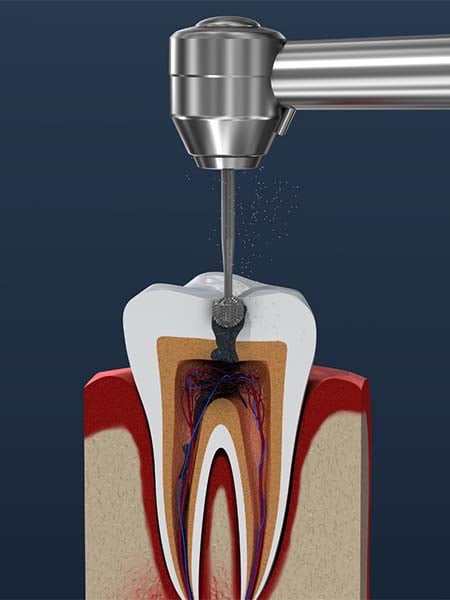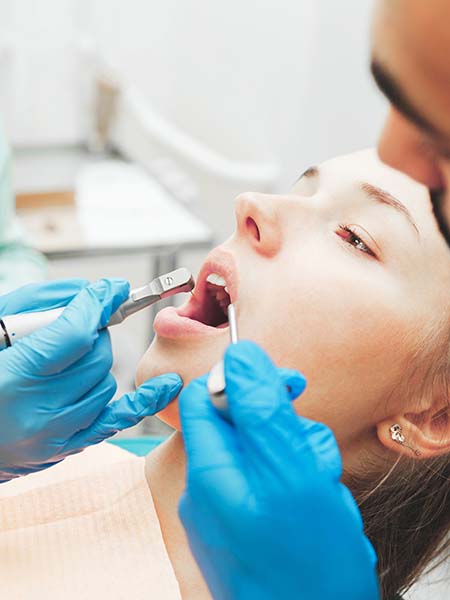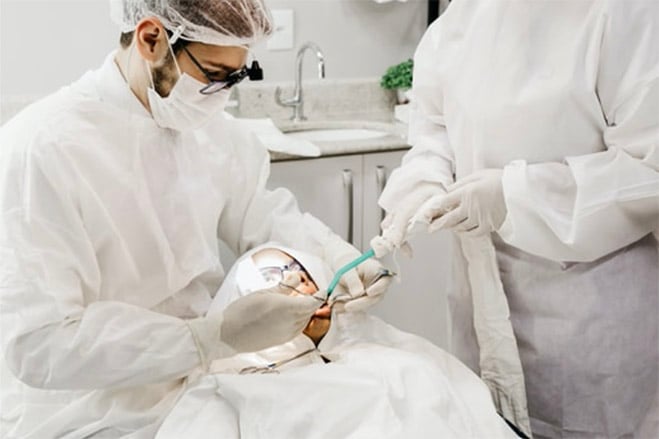.svg)
.svg)
.svg)
.svg)

Indirect Pulp Therapy
Indirect pulp therapy, also known as indirect pulp capping, is a procedure performed on a tooth where solely the outer dentin layers are affected by an infection, while the inner pulp of the teeth is unaffected and healthy.
It is a minimally invasive procedure that is meant to protect and restore a tooth, by reducing risk of exposure to the tooth's pulp.
It is mainly performed on children, and is suitable for primary teeth and young permanent teeth that are developing incorrectly.
What is Indirect Pulp Therapy?

What is Indirect Pulp Therapy?
In indirect pulp therapy, the pulp tissue is left untouched and covered with a biocompatible material, to prevent microleakage.
It is a minimally invasive alternative to an invasive techniques like pulpotomy. Unlike other methods, there is no reopening of the cavity for the treatment of deep caries lesions.
Long term retention of permanent molars requires a root with a favourable crown to root ratio and dentinal walls that are thick enough to function well.
Why Would You Require Indirect Pulp Therapy?

Why Would You Require Indirect Pulp Therapy?
Deep cavities requiring this therapy may have resulted from a variety of reasons, including:
- Tooth decay;
- Chipped or broken teeth;
- Moderate to severe tooth wear;
- Tooth abnormalities.

Benefits of Indirect Pulp Therapy
What Does the Procedure Involve?
Stage 1: Pre-Treatment
- To remove infected dentin, a bactericidal liner needs to be applied, such as calcium hydroxide, over the remaining carious dentin.
- This is to induce tertiary dentin (or reparative dentin) formation, protect the dental pulp tissue and stimulate healing and repair.
- This aids in the enhancement of the restorative material and tooth structure interfacial seal and for allowing adequate control of microleakage.
Stage 2: Indirect Pulp Therapy Procedure
- Indirect pulp therapy is a supplementary procedure in addition to placing a dental filling (composite resins). Just before your filling is placed, a layer of medication will be used to line the base of the cavity overlying your pulp.
- The medication has an anti-bacterial and soothing effect to help protect and heal your pulp, thereby preserving its health and vitality. The tooth is then restored with a material that seals the tooth from microleakage.
What Are the Risks Involved?
- As much as it aims to heal and soothe your pulp, a slight chance remains that your pulp condition may deteriorate in the future which may require a root canal treatment or extraction to address. However, in deep cavities with a healthy pulp, it is often worth attempting an indirect pulp therapy followed by a simple filling first as this is less invasive.
- The success of the treatment depends on the complete removal of decay from the walls of the cavity.
- f you are allergic to any known material (e.g. plasters), please inform our dentists beforehand so that we can plan the material to use to avoid any allergic reactions.
What Are the Risks Involved?

The Nuffield Dental Clinic Network In Singapore
Seletar Dental
Nuffield Dental Seletar
Greenwich V
1 Seletar Road #01-07/08
Singapore 807011

Kovan Dental
Nuffield Dental Kovan
Simon Plaza
2 Kovan Road #01-03
Singapore 548008

Serangoon Dental
Nuffield Dental Serangoon Gardens
Serangoon Garden Estate
57 Serangoon Garden Way
Singapore 555953

Siglap Dental
Nuffield Dental Siglap
The Domain
914 East Coast Road #01-03
Singapore 459108

Bedok Dental
Nuffield Dental Simpang Bedok
East Village
430 Upper Changi Road #01-64
Singapore 487048

Holland Village Dental
Nuffield Dental Holland Village
7 Holland Village Way #03-16
Singapore 275748

Jurong East Dental
Nuffield Dental Westgate
Westgate
3 Gateway Dr #04-32
Singapore 608532

HarbourFront Dental
Nuffield Dental HarbourFront
HarbourFront Centre
1 Maritime Square #02-64A
Singapore 099253

Orchard Dental
Nuffield Dental Jewel
Wheelock Place
501 Orchard Road #05-01
Singapore 238880

Raffles Place Dental
Nuffield Dental Raffles Place
One Raffles Place
1 Raffles Place #05-19
Singapore 048616


Book an Appointment
Fill out the form for any request or questions you have and we will contact you within one working day..


Why Choose Nuffield Dental?
Nuffield Dental is a one-stop, multi-disciplinary dental care centre. At Nuffield, we put you first. We believe in providing personalised service for each patient.
Nuffield Dental is a one-stop, multi-disciplinary dental care centre. Here at Nuffield Dental, we pride ourselves of our personalised oral care for each and every one of our patients. We need to make sure you get all the help you need to make your dental procedures comfortable, accessible and seamless.

Our dentists have been accredited in pulp treatment and oral surgery for 20+ years. We have accredited dental providers who are skilled in the area of dental implant surgery.
Articles
The newest and best lifestyle articles selected by our editorial team.

- 17 Nov 2025
- 2 mins read
Current scientific evidence does not show a conclusive connection between intact dental amalgam fillings and symptoms such as brain fog, chronic...

- 17 Nov 2025
- 2 mins read
The Minamata Convention on Mercury established 2034 as the global target year to end the use of dental amalgam. While this may seem gradual, the...

- 17 Nov 2025
- 2 mins read
Dental amalgam has been used in restorative dentistry for more than 150 years. It has long been regarded as a durable and practical material....
.png?width=2223&height=447&name=Background%20(4).png)




.png)

.png)



